Making of AUTOMATICA visual effects with thinkingParticles, and how he got from boring clerical work to become the founder of DigitalAxis
Roman Bilichenko on Music Video & visual effects
Cebas: Roman Bilichenko, how are you? Thank-you and welcome to cebas Insights Interview. Please give cebas an update about your current work status and feel free to comment on the VFX activities, learning opportunities and market in your region.
Roman Bilichenko: Hello there, my name is Roman and I am the founder of Digital Axis (https://digitalaxis.pro/). I live and work in Dnipro, Ukraine.
Cebas: Your video, ’Magma dancer test’ was what caught my eyes, as it involves thinkingParticles. You mentioned in it that you were testing TP import and you used TP as connections between RealFlow and VRay.
DigitalAxis.pro FX studio: thinkingParticles ‘Dancing Magma Person’ test from cebas Visual Technology Inc. on Vimeo.
Roman: I want to take this opportunity to thank you for inviting us to this interview. Yes, I really do use Thinking Particles for loading cache from RealFlow. To be honest with you, I am really happy that cebas is constantly developing updates for TP and increasing its toolset. I couldn’t keep myself away from making a few tests using the new features. Also, I am extremely happy about the appearance of Nodes, with the help of which you can export particles into Alembic – I really like this file format, it is lightning fast.
Cebas: How did you feel about TP in this Magma dancer test ? Did you like the results?
Roman: Yes, and I love the results, all channels work well.
Cebas: Your work is quite unique — especially in the field of Music Videos! What is more unique as well is that you are from Ukraine! I know there is a number of talented young VFX artists there, and would you say you are one of the best known 🙂
Roman: Thank you. It so happened that we started on our artistic path with postproduction of visual effects for music videos. After some time, the projects got more and more challenging, some even resembled short films. And, throughout this whole time, I have to continuously learn something new. I do not know, if I really am famous, I think that some close-knitted groups of people know me because of my professional output.
Cebas: Roman, the vfx community and followers of cebas channel would love to know more about you and how you came to be a freelance VFX artist on remote ! — can you please tell everyone some interesting history of how you trained to be a VFX artist in Ukraine? Some of the ups and downs of your VFX journey, and some memorable stories or experiences you have had with people in your journey that had influenced your work?
Roman: The first money that I have ever made for a render was in 2004. It continued till 2008, then I dropped this kind of work and never returned to it again. But, I could never leave this work for long – I am talking about computer graphics in general now. I really wanted to do this all the time, it was what I constantly thought about when I was doing anything else.
I wasn’t making any projects, I was just making tests — personal RnD — one after the other. Maybe, it was my education that had something to do with it, I graduated from a junior college and then University as a computer science major, so it is very interesting for me to investigate how does a program work, how does it do the things it does, algorithms, formulas, etc. I read a lot about that in my days. And, for a long while I couldn’t decide what exactly did I want to apply myself towards – programming or CG? In the end, it was Computer Graphics as it proved to be more satisfying work for me.
In 2008 when I was working for a bank, I was already seriously involved in CG work and that was the time when I started to make 3D Model. (See examples) They were simple models but it was only after I started doing modeling that I understood that I wanted to do CG professionally rather than just a hobby. I dreamed that my hobby would develop into a career someday.
In 2010, I found a group of people who, were involved in CG, just as I was. We started working for the Russian market. I remember that we were all burning with desire to do more and to continue doing that which brings us such pleasure while at the same time making money, but of course, there wasn’t a lot of money to say the least. Still, it was very exhilarating and rewarding.
You can’t even imagine what it was like to finally find myself without the need to stay board up in an office and do all the boring clerical work, which I hated by the way. But instead, I got to do that which I loved with a team of people who lived what I lived and thought what I thought. It was really awesome!
Cebas: Roman, what about your path of training? Can you tell us something about this?
Roman: It was precisely simulation that I began to study in 2011. I knew what FumeFX and Realflow were, because I had tested them, if I’m not mistaken somewhere in the years between 2003 and 2005. I began to study Particles in 2012, we got a project, where it was necessary to destroy a parking lot, and I tried different tools, but thinkingParticles allowed the destruction scene to be done very quickly and I was pleased with the result.
I really liked the simplicity and convenience of the TP plugin, but most of all I liked how the collision engine worked, it was something very cool, not like anything I had ever seen before, this neatness and the effects of viscoelasticity, if you know what I mean. That was precisely why I fell in love with thinkingParticles. As a matter of fact, it was the beginning of 2012, when my friend Alex and I started studying particles, ‘studied’ mostly by poking around — yes, lessons were readily available then, and out of those that were available, they didn’t explain how this or that parameter worked. In the same year, I registered for Vimeo, and from that year I switched exclusively to studying simulations, so far this is one of my favorite processes along with visualization. I worked for a Ukrainian company in visual effects and also I worked with many studios from Ukraine as a freelancer. I did different tasks, I was what they call a generalist.
By 2013, I started doing shots myself. I did everything from modeling and simulations to compositing. To be clear, when shots were assigned to me, I myself went through all the stages, I had a lot of energy and inspiration.
In 2014, I developed a team in the company where I worked and I continued managing the full cycle of visual effects processes, but this time not by myself, but with a team continuing to take the most complex shots for myslef. I worked with many directors, and we did a lot of really good things for cool people, for stars I mean. Stars like Chris Brown, Shakira, Lady Gaga, Britney Spears, my team did the most difficult projects. In the autumn of 2015, I left the company, and founded a company of my own with the people who followed me, we went through a lot together.
Now, we are working on interesting and complex projects, and with the work that we did, we have somethings that will surprise the biggest sceptics out there.
Cebas: how did you first started ? I mean going into an art career.
Roman: Everything was started as long ago in 1999, a younger me with Microsoft Paint. I started trying to draw. I really liked it. A year later I got my hands on some 3D Max. One of my buddies showed me this program. His task was to use it to model and program a clock, so that they will be permanently set on his desktop.
I think I must have lost the power of speech when I saw this. Just imagine what was my level of amazement after MS Paint. I remember that there were test scenes; there was a scene with a robot that was set for animation – I was in pure shock. When I pressed an autokey – the key was enabled and all movements were recorded. I completely stopped playing video games and everything else for that matter as I understood the full depth of this tool and fell in love with it.
But more than anything, I fell in love with rendering. I was just mesmerized with how the program calculated light, shade, especially deflection, for me it was an absolute fantasy coming to life. I studied everything little by little. When I connected to the internet for the first time, I found out about Mental Ray, and indirect light. I found out about such effects as motion blur and depth of field. I was working with version 3.1 of 3D Max and I simply could not connect it to Mental Ray.
In all honesty, I was happy with what I had. My first introduction to indirect light happened with Vray and 3D Max 5. I was infected with the idea of light and it is my favorite process till this day – materials and light. The first time Mental Ray was incorporated into 3D Max was when verion 6.0 came out and all my attention shifted to it, I remember making all kinds of tests on my own time, it was pure pleasure.
Cebas: The music video ‘’CLMD — Never Wanna Lose You…’ Now, was this for an American productions? You had a drone in there with some TP effects ? It was quite futuristic.
Roman: Yes, and CLMD has finally moved to America. But he is originally from Norway, we worked with Frederic on this project, there was also a Norwegian director involved. That’s right, I used TP to simulate the behavior of the leaves. It was a cool project, we did it in 2 weeks, so there was not much time, I put together a setup in a few hours, tested it, and used it for a shot with the exploding drone.
Cebas: And today Roman, we are going to talk about your major achievement and that is with a New Zealand music artist, Nigel Stanford’s AUTOMATICA, you had used TP for all the destruction scene in there — the robot laser beam, table, guitar crash, sparks flying … did you enjoyed it ?
Roman: It was an absolutely amazing… and difficult project. At first, it may seem that there are not many visual effects here, but it’s only because we worked on every particle, every spark to make it look as natural as possible, so that it merged with the music video footage, and interacted as much as possible with real objects. Smoke flowed around obstacles, sparks fought against tables, the floor, columns, lasers, destruction, so that everything would find its target for interaction. (see main video atop for AUTOMATICA TP FX breakdown)
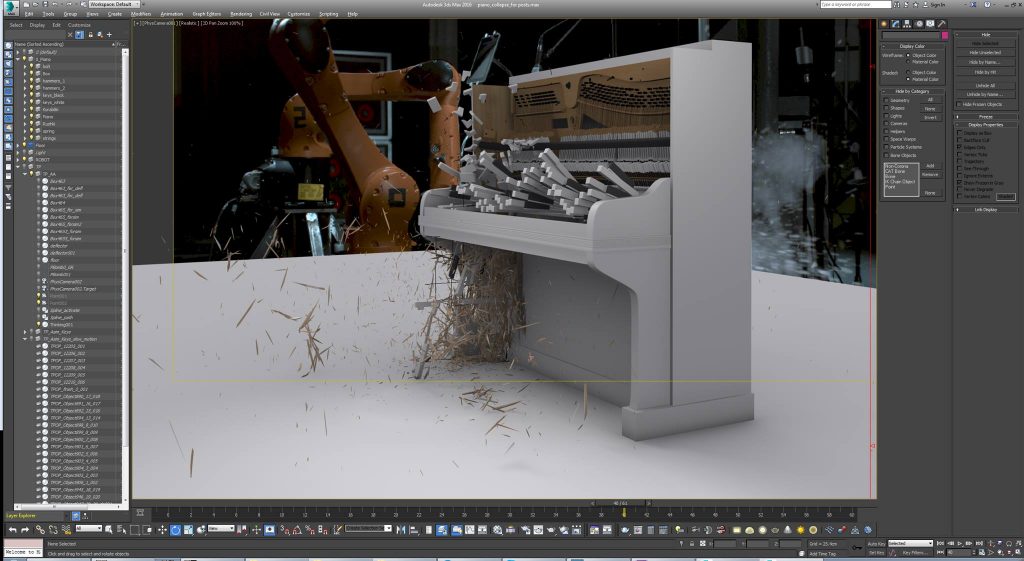
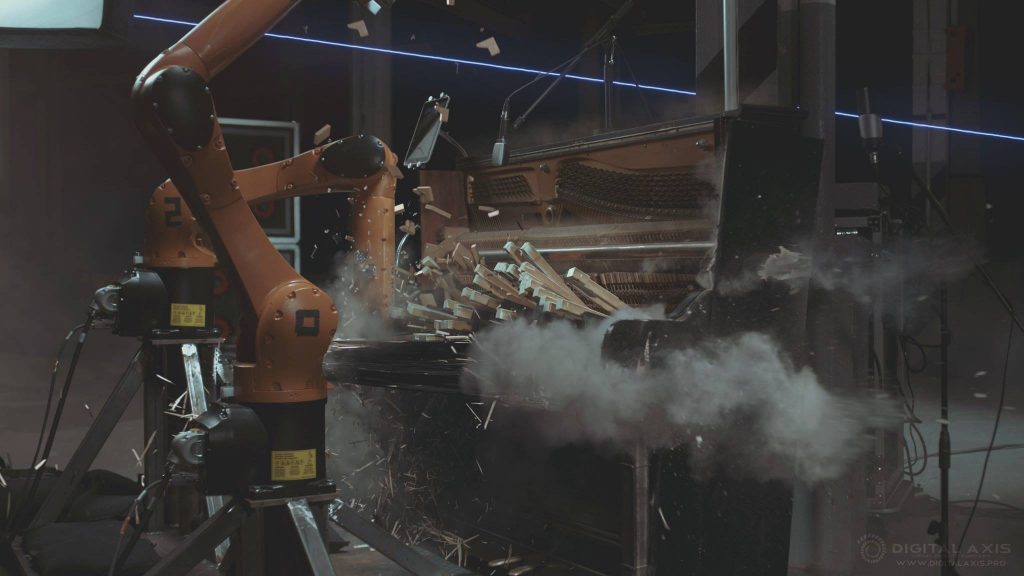
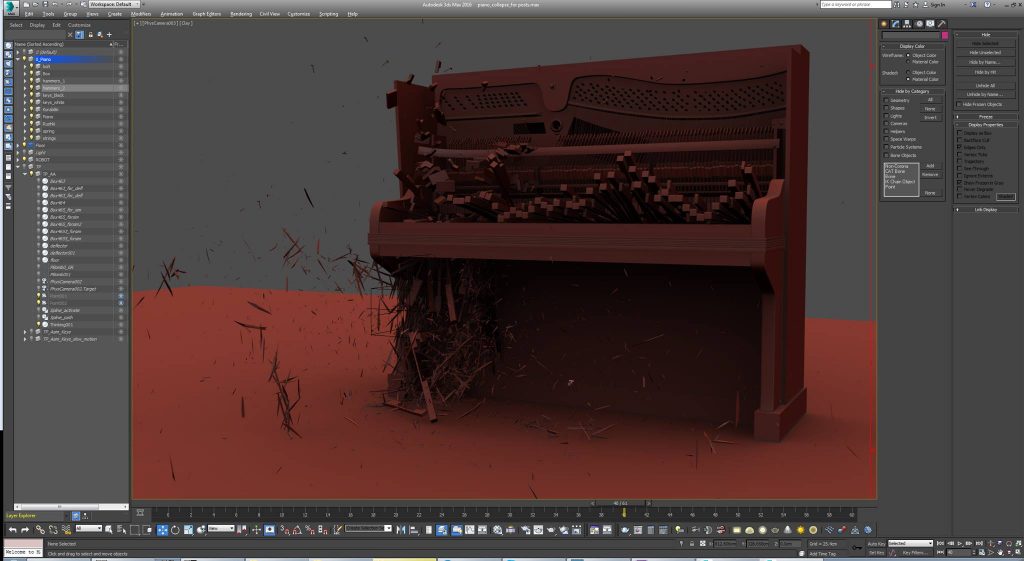
The most important thing in this project was not to flaunt the visual effects in front of the viewer, but to hide them as much as possible, disguising them as real special effects. Nigel is a unique client, he is unique in that he knows 100 percent what he wants, only very few times when I asked him to leave it as I see it, and by the way – there was no problem with that. This is called cooperation! This is a colossal experience, thanks to such projects, the company grows, the team’s skills are growing, we just complement each other. As they say, one head is good but two is better.
Cebas: How did you get involved from Ukraine to NZ?
Roman: See, I just wrote to Nigel, showed my demo reel, and we started our cooperation. Now we are working on our next project, unfortunately I cannot say what it is, but it will be so cool. Soon, you’ll see.
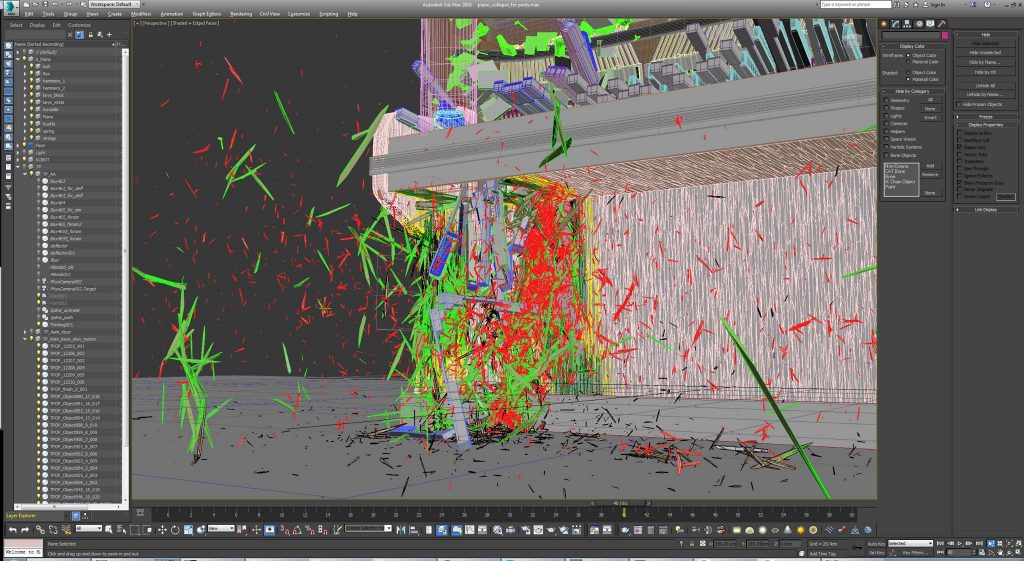
( NOTE : Roman has kindly agreed to a time lapse tutorial from his production work on how to create ‘dust clouds’ & ‘seismic trails’ using FumeFX and thinkingParticles.
To access, please register a free account at cebas.com and access the Training Resource for the video and other training sites. Info on TP or finalRender educational licenses, write to 3dgallery@cebas.com)

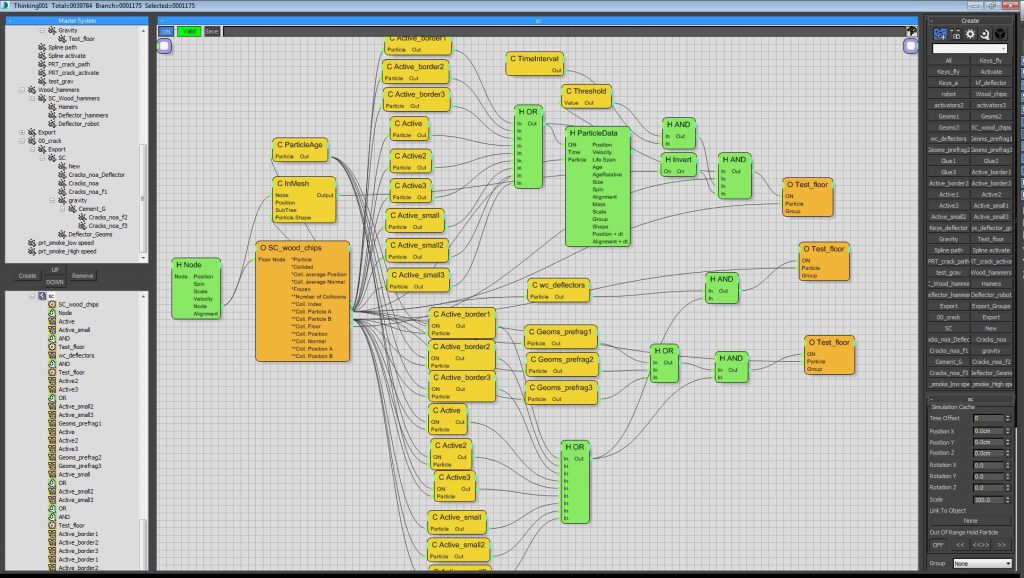
Cebas: Did you have to stayed up late with the time zone differences?
Roman: We have a 10 hour time difference with New Zealand. But we are used to working on Los Angeles and New York time. So the most efficient hours for us are from 11 am-to 10 or 11 pm. The most persistent of us last till somewhere around 2 am. And it is like this every day.
Sometimes you have to work for 20 hours straight! So we do everything for the project to be delivered in time. This is important for us.
Cebas: Did you feel one great vfx work you done with the first music video like CLMD eventually led to production companies or music artists coming to you with more projects?
Roman: CMLD wasn’t our first project that my team did together, we had about 20 projects before that. Some projects, we haven’t yet published to our website, for one reason or another. I had a lot of experience working with different directors, so now we are working with them, the same directors only with a much more dedicated and more skilled team, paying maximum attention to every project, if the customer is happy, we are happy too.
Cebas: Which Thinking Particles features helped you the most in this music video? Were the blackboxes helpful in any way?
Roman: I consider TP a very successful tool, thanks to its structure, it is very visual and convenient to use. It took me a week to master the first steps and use it for the first project in which we had a destruction scene, it was a destruction of a parking lot. I really enjoyed working with this product. As for AUTOMATICA, I did not use any black boxes, I did everything from scratch, we had some templates for the cracks, but I had to modify them.
TP Black boxes are a cool thing! But, I just do not have enough time to explore all my developments, I just save everything together with the scenes, and if I need something, I just pull this information out and then use it.
Cebas: Why did you decide to use TP for Automatica ? Did it help you achieve the desired effects without much issues in integrating different software in your studio pipeline?
Roman: I don’t know tools that could come close to TP on dynamics except perhaps Houdini. But since our pipeline is tied to 3ds max, I was looking for a tool for this specific environment. I cannot say that everything is going smoothly. They are, in fact, different tools to integrate. Sometimes, as a matter of fact I could say quite often that 3ds Max crashes – that’s very bad.
For example, in a shot where the piano is smashed by the robot, I did not have any problems with geometry simulation, but 3D max often crashed when I tried to simulate smoke.
I followed a standard routine – clad particles with geometry and checked speed. As soon as the speed was above the permissible threshold, I activated the smoke. There were about 450 thousand particles. And this was the problem, I spent a few days to find out the reason, but I could not find a solution, I decided to cheat a little. I just waited until there was enough dust, and reduced the number of particles with each frame. Less particles, fewer dust sources, less memory needed, faster simulation. The last two shots were the most labor-consuming, they destroyed the ceiling – (kartika) We had to buy additional RAM, because we could not bring the whole scene together, it’s on a full CG environment!
Everything is three-dimensional here in the music video, except Nigel the musician and the robotic arms. There are a lot of splinters lying on the floor, falling from the ceiling, huge crumbling slabs with a protruding reinforcements, lots of smoke, sparks, voluminous light, a huge logo on the floor, this is by far the most complicated shot in the whole project.
Cebas: here is so much to ask you Roman, tell us how and when you set up the Digital Axis? How long has it been?
Roman: Everything began in the fall of 2015. I decided it was time to organize my own community. I had some kind of a budget for this, I proposed to cooperate with others for the sake of a common goal. The invitation went out to my wife, Olga and my colleague, Ruslan with whom we worked for more than 5 years. While I came up with a logo, the studio name, a splashscreen for the company, the guys found an office, bought furniture and equipment. In the beginning, we worked just the four of us, then 2 more people joined, as of today we have 11 people and 5 more on freelance. This is a big team, which you need to control, so I have to deal with the organization more than the actual work.
In the case that the project is of high complexity, I also join in on the project. I’m always aware of all projects in the company, even if there are quite a few. I think things through 100 times, calculate and weigh everything in before taking on such projects, because this is a risk, the risk is not delivering on time
It is necessary to regulate the dose of tasks for people and manage the team, to switch and direct the guys and that is a lot of work. Unfortunately there is so less time for CG work compare to when I was doing freelancing a while back! But organizational work is also cool, I like everything, I like to feel that there is a large team that has my back that will give many today’s best studios a run for their money, where the number of people is much larger than ours. We do not pursue money, the main thing for us is quality. As is written on our website – our philosophy is – living the project. And that is 100% true.
Cebas: Do you plan to expand DigitalAxis?
Roman: Because when we are involved in some projects, especially something major like the AUTOMATICA or HIGHLY SUSPECT, you’re always thinking about these projects, even at home, I go to bed and I think about the next steps, or some kind of a concept that is needed. Our tasks are very different, we recently made a clip in which the main characters almost look like a priest – almost, it was funny, Nigel’s Robots made music and carry a hangar, flying saucers, drones, cars, planes, magic, trees and a lot more.
But whatever it is that we do, the main goal is to build quality, even if the deadline is tomorrow. We also had some very ridiculous deadlines for which it would be unrealistic to complete this work!
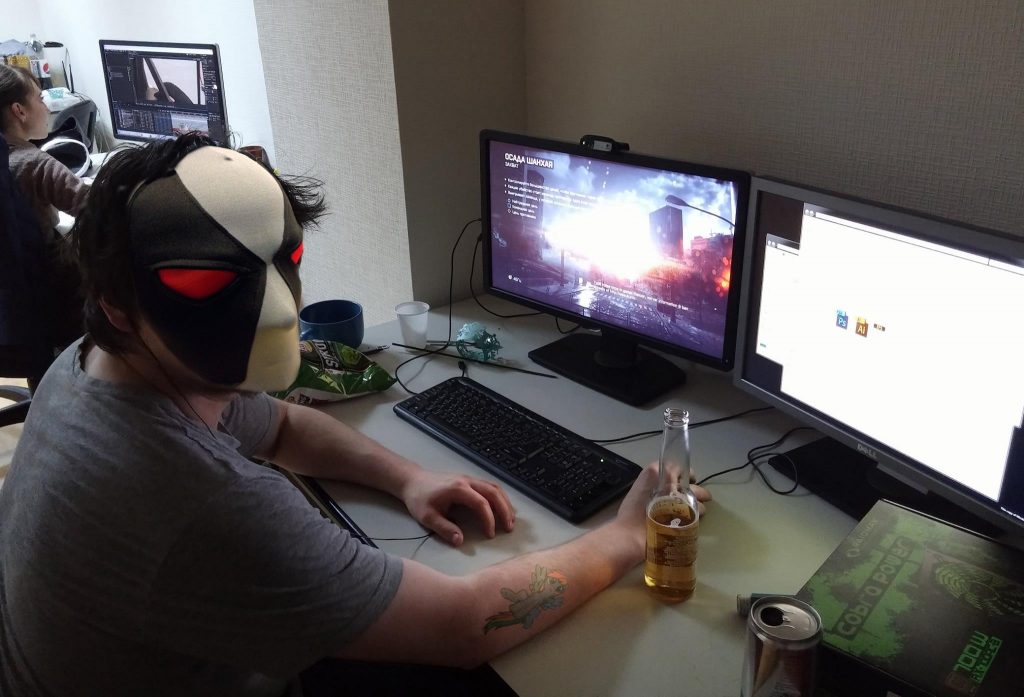
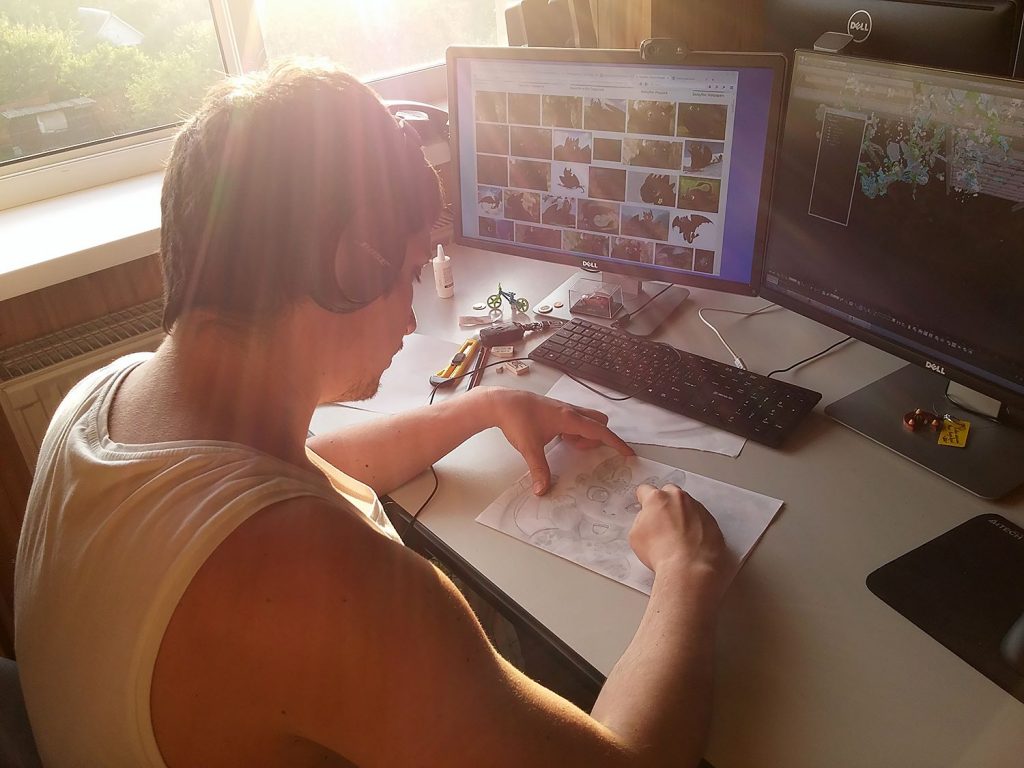
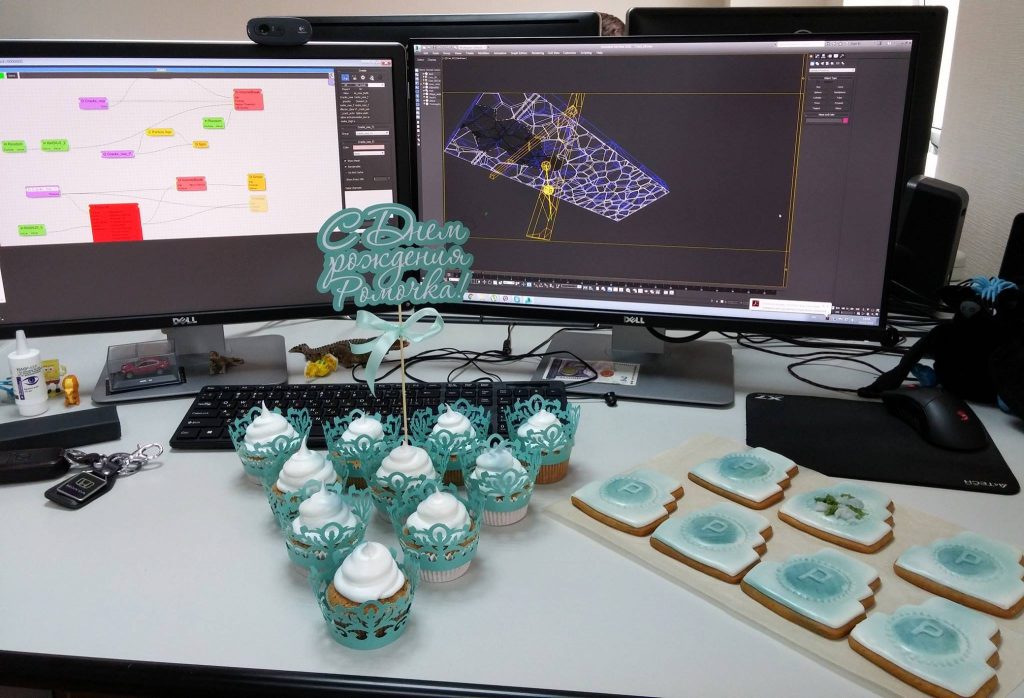
I plan to expand the team, but gradually. You know, it’s very difficult to find really cool folks, like those who work for us, for them work is their favorite thing. I think that having such a team that will run into a burning building with you is a ‘total buzz’, man! But unfortunately out of 15 to 30 people, only one is elected to join the team ?
Cebas: Digital Axis is involved in music videos / film / commercial / motion design and 360. Do you ever get to sleep with so much work? ?
Roman: We try to get some sleep every now and then. Unfortunately in most cases, the deadlines are pushing us to work for 14 hour days, sometimes more. So sometimes you have to work for 16 hours, 5 hours for sleep and then again. Sometimes something incredible happens last minute, and then we work until the end, and then sleep — this is the lifestyle.
Basically we may allow ourselves an 8-hour good sleep once in awhile ? After all, good night’s sleep is the basis for good work, right?
Cebas: Where do you see thinkingParticles in terms of 360-based projects? What is ready for use now with 360 VR-capabilities and what are still the remaining challenges?
Roman: Actually, a 360 project is an ordinary project, the only difference is that you need to work with a resolution of 6 to 10k. And this is not easy and not as fast as Full HD 1080. On AUTOMATICA, some shots were in 6k, we had to do an upgrade of all hardwares so that we could work with such enormous data. One frame in such a sequence can take up to 300 mb, and there are 500 frames in a shot, this is dedicating 150 gb only for sequencing. A minimum of 32 gigabytes of RAM is required.
Now we are working with Nigel Stanford, Sound Expert in New York, on a new project and the first shot that we are making is in 8k, one frame of the final sequence took up 500 mb ! Just the visualization part of the project takes 5 hours on 6 computers. This means that every time we need to show Nigel this shot, we need to render for that long. I plan to buy a farm, at least 20 nodes. Then you can talk about full-fledged work in VR360 and stereo VR360.
Cebas: Roman, how helpful are the BlackBoxes in TP?
Roman: In reality, this is an incredible feature and very convenient. I have some prototypes, but they are not finished, others are not quite procedural to be called BlackBox. So unfortunately, the tasks are very individualistic, and you have to do everything from scratch. Sometimes, I connect some procedural dynamic sets, some complicated conditions or complex search, and I use them in my systems.
Cebas: What do you find usually are the most difficult aspects of 3d/ VFX work – is it technology or artistic inspiration ? – is there an available vfx software that resolves all your technology-to-creativity needs? What is missing?
Roman: At the moment, we do not have a single tool that would comply with all our creative and technical needs. We encounter a variety of needs and do get involved with quite a big number of plugins while we work, which proves to be more and more challenging as the quantity of these plugins grows with increased level of difficulties, that our coming projects demands.
We also encounter problems, where these plugins don’t function well together. I mean they work alright, but not as they should in some situations.
In my opinion, difficulty directly correlates to the type of task that needs to be done. It so happens every now and then that a task might include quite a few non-trivial tasks, like a number of simulation coupled with a fairly difficult lighting and as you can imagine, it will still absorb substantial amount of studio time to resolve these kinds of issues in such instances.
Cebas: Roman , could you give some insights as to what opportunities is there in Ukraine, your city, in terms of learning thinkingParticles and other VFX software?
Roman: In our city there are several academies that teach 3d graphics. But they give the basics and no more. Everything else you should learn on the job, when there are tasks. And based on individual initiative to resolve the task by any means. If we talk about the whole of Ukraine, I don’t know …. but I’m not aware that there are any schools trying to teach vfx or complex simulations, Ukraine is only at the beginning of its road for this type of work.
Cebas: And apparently the VFX market in Ukraine is still very young, is it ? And you and Digital Axis is a big boost to creating more knowledge and skills in this area?
Roman: Yes, this is true. We all learning from each other and helping each other. Working in a team is cool. I’m sure that no school will teach you better than doing a real project, real time, and work in a real team of like-minded people.
Cebas: Finally, Roman, in your view, what is your wish for cebas software to achieve that is not currently doing for you?
Roman: If we consider tp in particular, I would like to see in it all dynamic aspects of objects. It would be great if one tool had everything: Rigid body collision, water, granular simulation, clothes, fire, smoke and other volumetric effects.. But i think that we are almost there actually with tp 6. Because something like this already exists in tp, and we just need to develop it to be more powerful.
Cebas: And what projects can we expect from you in the future (if you’re able to tell us)?
Roman: I can only say that there will be many. I will keep you in the loop. If we get an interesting project where I will use thinkingParticles, i will come up with some kind of review.
Cebas: What are your professional and what are your personal hopes and dreams in moving into the future in the art of visual effects and balancing life/work?
Roman: I really like the art of filmmaking. It is an amazing roller coaster ride. If the film is actually good, you will lose yourself in it for a couple of hours and forget about everything: your problems, your tasks… I plan to get into filmmaking, the idea is to start from short films and grow from there. I even came up with a few interesting plots. I hope that some day it will happen for me.
I would also like to devote more time to producing educational courses, and to further develop Black Boxes – I’ve been wanting to get my hands on that for a while. Really, there are a lot of things, but unfortunately, time is the factor here and there is so little of it.
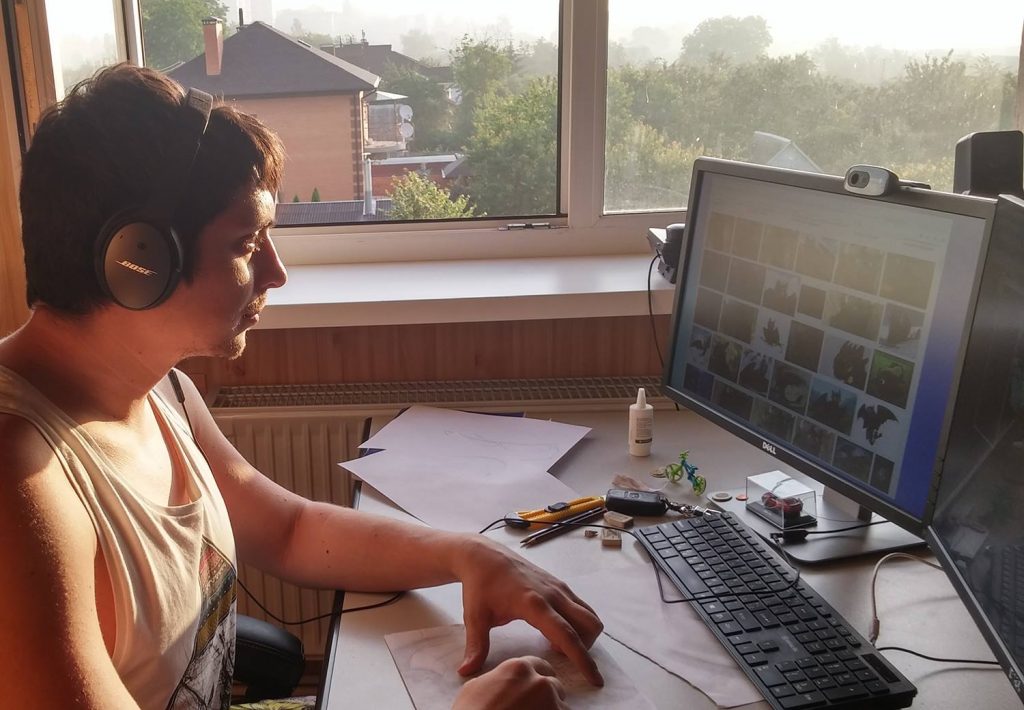

UP NEXT: keep tab for Cebas next feature story about AUTOMATICA’s creator, Nigel Stanford where Nigel talks about his inspiration and music productions with robotic arms, playing musical instruments!
Cebas Visual Technology would like to say a Big Thank-You to Roman Bilichenko, DigitalAxis.pro and Nigel Stanford nigelstanford.com for the exclusive on the Making of AUTOMATICA, music video and visual effects! Follow Roman Bilichenko on Facebook.

